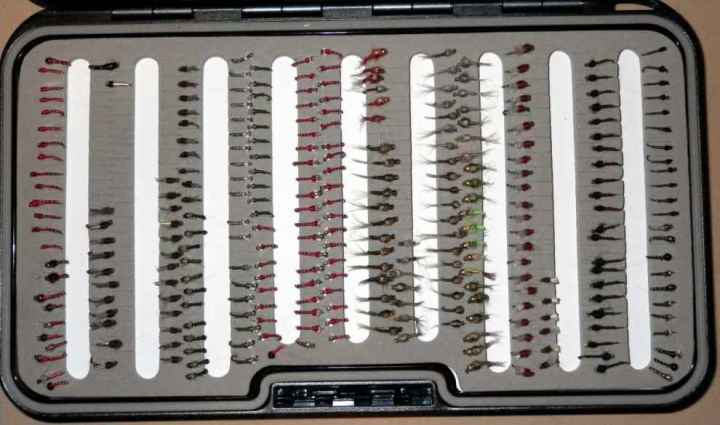Larry, we gotta fish. You really covered the material well.
That's whats nice about this midge thing, 1 box of flies, umpteen ways to use them.
A twenty foot leader with a pop off indy, and fish a midge just off the bottom. Or a s-l-o-w wind up retrieve. It can be stripped up from the deep on a sinking line, or suspended on sink tip line or dangling just under a dry (Kelly's style). These different techniques work because the fish feed in different parts of the water column at different times.
But they are always eating midges. The trick is to know which to do when you're sitting there.
No rings or rises, high noon, try deep. Swirls but no backs or noses, fish down a ways and strip up..
See a bulge or back, dangle your offering under the dry. Happier thermoclines make the fish move around to be comfortable. Bright sun can have an effect as well. Maybe sending them down at high noon, but shallow early and late. Clouds may bring them up all day long. In the river, I often use 3 abs, a big heavy nymph, with a little zebra midge dangling 8"down off the bend. No indy, and Zen high sticking. I've mentioned dangling one behind a streamer on the swing. Evil!
I am in testing this year, using the tungsten impregnated leaders (for rivers), to cut down on the count down method you mentioned for lakes (instead of adding weight). Kinda wondered if Mojo and Joni have tried this.
My only hesitation in the info you gave, is the overhand knot trick for split shot. Drop shotting??? I know everybody's doin' it. But I have had prospect clients quiz me whether I did it. Told me later they wouldn't of hired me if I had said yes. Fly snobs? Not even sure it's legal out here. But a deadly technique for sure. I see the logic.
Midge fishing, takes can be so subtle, that when fishing in a lake I bury my rod tip and strip set rather than rod set. Straight line is the shortest distance between two points.
One day last year, I had takes so subtle that I laid the line across my palm and waited to see the line move across it. Maybe an inch, or two. I did this as a kid with bass. They just super slowly swim away with it. Till I did this, they were just picking it up and dropping it without me ever knowing that someone was home.
All time favorite midge expirience was throwing #20 white dry midges on a lake from a boat. It was midnight and no moon, and breaking off VLFs with strong takes on 4x flouo. Couldn't see a thing. But you could hear it. WOOHOO.
Jim

